Although India has the highest percentage of habitual savers (59%) (As per the survey conducted by Aegon Insurance across 15 countries), one thing that bothers most individuals during the golden years is the possibility of outliving their entire retirement corpus. But this worry can be addressed by investing wisely from an early age .
Before we delve into the subject matter; here are a couple of questions for an honest introspection:
- Have you provided for a pension facility? (The answer would be a "no" if you are working for a private limited company)
- Would you be keen to have a pension for life if provided by a Government of India Agency? (The answer would mostly be a "yes")
The investment avenue that we are talking about here is the "National Pension System (NPS)" offered by the Pension Fund Regulatory and Development Authority (PFRDA). Over the years, subscriptions have jumped from 4 lakh in March 2009 to 123 lakh in March 2016.
If you are wondering how it works, here's a snapshot and it's features:
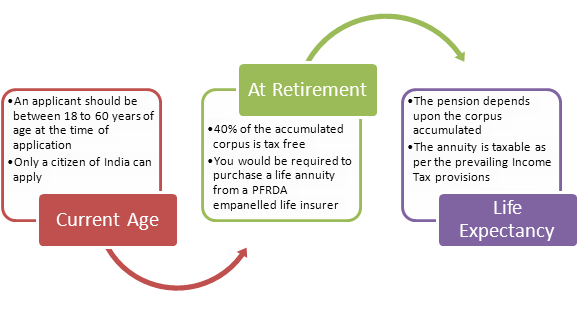
(Source: PersonalFN Research)
- NPS is a voluntary defined contribution scheme (i.e. the pension you receive depends on the retirement corpus accumulated over the years)
- The investments are pooled together and managed by professional fund managers appointed by PFRDA
- You have the flexibility of deciding the portfolio you wish to invest in (bonds, bills, corporate debentures, and shares)
- At the time of normal exit from NPS, you would be required to mandatorily purchase a life annuity from a PFRDA empanelled life insurer.
- A citizen of India (whether a resident or a non-resident) can participate in the NPS-All Citizen Model
The All Citizen Model (Unorganised Sector-UoS) offers two investment accounts—Tier I and Tier II with varied features:
| Particulars |
Tier I |
Tier II |
| Minimum Contribution at the time of account opening (Rs) |
500 |
1,000 |
| Minimum amount per contribution (Rs) |
500 |
250 |
| Minimum total contribution in the year (Rs) |
6,000 |
2,000 |
| Minimum frequency of contributions |
1 per year |
1 per year |
(Source: PersonalFN Research)
- Tier I Account: It is a non-withdrawal account, which means the applicant isn't allowed to withdraw the contributions he has made. The objective of the account is to build a retirement corpus. The good news is an applicant is eligible to claim tax benefits on their contributions. The minimum amount to be contributed every year is Rs 6,000 (excluding charges and taxes) and can be made in multiples of Rs 500. If the applicant fails to contribute Rs 6,000 in a year, then his account would be frozen till the shortfall along with penalty isn't paid (Rs 100 per year of default)
- Tier II Account: This is a voluntary savings account and isn't linked to retirement. An applicant is free to withdraw from this account as per his requirement but isn't eligible to claim tax benefits on the contributions made. The minimum amount to be maintained is Rs 2,000 per year
NPS offers an applicant freedom to decide how his money will be invested. It offers two options—Active Choice and Auto Choice
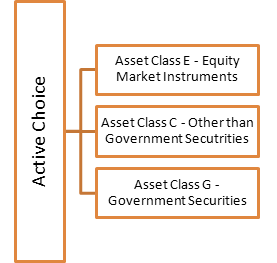
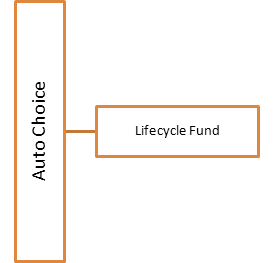
(Source: PersonalFN Research)
For applicants investing in Active Choice, the entire pension wealth can be invested in Asset Class C or G and up to a maximum of 50% in equity (i.e. Asset Class E). While those investors lacking knowledge to manage their NPS investment can opt for Auto Choice (i.e. Lifecycle Fund). Here, the fraction of funds invested across three asset classes will be determined by a pre-defined portfolio.
The NPS offers 3 options for a subscriber to exit/withdraw the corpus as explained below:
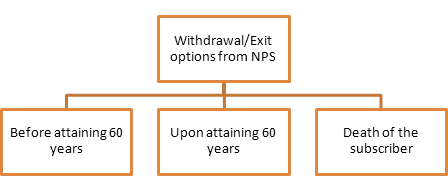
(Source: PersonalFN Research)
- Before attaining 60 years: At least 80% of the accumulated corpus needs to be mandatorily used to purchase a life annuity and the balance 20% is paid in lump sum
- Upon attaining 60 years: At least 40% of the accumulated corpus needs to be mandatorily used to purchase a life annuity and the balance 60% is paid in lump sum. 40% of the accumulated retirement corpus is made tax free at the time of retirement as per the Union Budget of 2016 – 17. However, the subscriber has the option to defer the lump sum withdrawal till the age of 70 years.
- Death of the subscriber: The entire accumulated corpus (i.e. 100%) would be paid to the nominee or legal heir. There will not be any purchase of annuity and the entire proceeds received will be tax free in the hands of the nominee/legal heir as the Union Budget of 2016 – 17.
Some key developments:
- Over the years the asset under management (AUM) of NPS has grown from Rs 2,277 Crore as on March 2009 to Rs 1,18,810 Crore as on March 2016
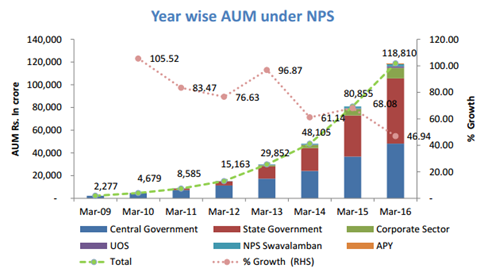
(Source: www.pfrda.org.in)
- Moreover, Pension Fund Managers (PFMs) have clocked encouraging returns over the period
| Schemes |
Pension Funds (Returns since inception) (in %) |
| SBI |
UTI |
LIC |
Kotak |
Reliance |
ICICI |
HDFC |
| Central Government (CG) |
10.35 |
9.89 |
10.01 |
- |
- |
- |
- |
| State Government (SG) |
9.88 |
9.94 |
10.08 |
- |
- |
- |
- |
| Corporate Mode - CG |
10.38 |
- |
10.64 |
- |
- |
- |
- |
| Tier I |
E |
8.85 |
11.22 |
13.15 |
9.79 |
10.25 |
11.34 |
16.06 |
| C |
11.14 |
9.67 |
11.90 |
11.00 |
9.46 |
11.05 |
11.77 |
| G |
10.03 |
8.66 |
12.34 |
8.82 |
8.46 |
8.92 |
11.37 |
| Tier II |
E |
8.37 |
8.77 |
6.58 |
8.92 |
8.64 |
8.46 |
10.3 |
| C |
10.77 |
9.90 |
9.77 |
9.54 |
10.58 |
11.26 |
10.84 |
| G |
10.28 |
9.90 |
12.81 |
8.66 |
8.83 |
9.12 |
12.22 |
| NPS Swavalamban |
11.02 |
10.86 |
10.79 |
11.15 |
- |
- |
- |
(The table indicates returns as on 30th June, 2016)
(Source: www.pfrda.org.in)
However, out of Rs 1,18,810 Crore AUM (as on March 2016), only Rs 1,333.16 Crore was the AUM under Tier I & Rs 192.84 Crore under Tier II for the All Citizen Model. This highlights couple of inefficiencies of this model to attract the common man:
- Inefficient Taxation: NPS does not enjoy the Exempt-Exempt-Exempt status unlike Employees Provident Fund (EPF) and Public Provident Fund (PPF). As per the current tax laws, 60% of the accumulated retirement corpus will be brought under the tax ambit, making it unpopular vis-à-vis PPF. Moreover, the life annuity that a subscriber has to mandatorily purchase from the retirement corpus is also taxable as per the prevailing tax laws.
- Inability to beat inflation: A subscriber to the NPS is forced to buy a life annuity from a life insurance company. Annuities offer paltry returns (in the range of 3% to 7% pre-tax) making it an incompetent instrument to beat inflation.
However, in the bid to attract more subscribers and embrace technology; PFRDA has taken some key initiatives:
- Mobile App: Mobile App for NPS is now available to the subscribers in "Google Play Store" as "NPS by NSDL e-Gov". By using the app, one can:
- Transaction Statement: Raise request for transaction statement for a particular financial year.
- Account details: View NPS account details
- Statement of holding view: Details of scheme wise units along with latest NAV and the total value of the schemes (as on date) is available.
- View of last 5 contributions: Details of the last five contributions credited will be available i.e. credit date, tier type, amount and contribution remarks.
- Change in contact details (Telephone/Mobile no /email ID): At present, subscriber can change his/her contact details in CRA system using login credential. The same feature has been extended in Mobile App.
- Change password/Security question: Subscriber can add / modify his / her password and set security question (for password reset) through Mobile App. Subscriber will also be able to reset his/her password by answering secret questions.
- Notifications: Notifications, if any, from CRA will be available to the Subscriber. Short messages will be displayed here.
- Change of address using Aadhaar authentication: The subscribers can now update/modify their address using Aadhaar based authentication. The subscriber will also be permitted to add their permanent as well as correspondence address
- Scheme Preference change facility: The NPS Subscribers associated with All Citizens of India (UoS), Corporate sector and Government sector (for Tier II only) can now change their Scheme Preference by logging in. An OTP will be generated on the registered mobile number and after confirmation, the subscriber can change the Pension Fund Manager (PFM), Asset Class, Allocation Ratio and Scheme Options
- Tier II activation through eNPS: Any subscriber having a Tier I account in NPS can now activate a Tier II account online through eNPS. To activate a Tier II account, the subscriber has to enter their Permanent Retirement Account Number (PRAN), Date of Birth (DOB), and Permanent Account Number (PAN). Once the details are submitted, an OTP will be generated on the registered mobile number and after confirmation; the subscriber can go ahead and activate the Tier II account.
- KYC re-verification using Aadhaar authentication: A subscriber whose bank has not confirmed (rejected) his/her KYC verification request can now update their address details and confirm KYC using Aadhaar based authentication. He can do so using the eNPS module.
- Facility to contribute online: Subscribers are contributing through online mode using eNPS portal of NPS Trust. A facility has been made available to contribute online for subscribers using IPIN credentials in CRA system.
- Withdrawal from Tier II account: Till now a subscriber had to travel to the branch of the Point of Presence (POP) or Nodal Office mapped to his account. This caused a lot of inconvenience to the subscriber. Taking cue, PFRDA has come up with a facility wherein the subscriber can withdraw from his Tier II account using his login credentials and authenticating the OTP generated on his registered mobile number.
- Online IPIN generation: This facility will help a subscriber access his NPS account immediately without waiting for a physical I-PIN to be despatched in the post.
To Conclude…
As Financial Planners with over a decade of experience, we believe this product does not hold enough promise to create a substantial corpus that will meet your retirement need citing its inability to beat inflation and inefficiency to save taxes.
Even if a subscriber decides to apply for one, it won't be prudent to be completely dependent on this single instrument as one plan for the golden years.
Rather, if you chalk-out a prudent financial plan with the help of a financial planner, and invest wisely as per the plan laid out (which would mostly recommend you equity allocation at younger age, and then as your age progresses balance the asset allocation between equity and debt instruments), then the corpus that you create will be substantial enough to meet your retirements needs.
Add Comments
| Comments |
pijushhaldar@gmail.com
Aug 16, 2016
The fact that their is tax benefit at investment is not taken in account, a 30% tax benefit is possible yearly.
Also, the overall return over the years is more than inflation and more than any other investment options that are presently available . so the corpus built will be good, buying annuity is the only concern which can be addressed separately. |
meetnkd@yahoo.com
May 02, 2020
Bad analysis, you don't need annuity returns to beat the inflation, that is when you actually need a stable income. Inflation is beaten during investment years by having good equity allocation. |
meetnkd@yahoo.com
May 02, 2020
Bad analysis, you don't need annuity returns to beat the inflation, that is when you actually need a stable income. Inflation is beaten during investment years by having good equity allocation. |
ohrisamir16@gmail.com
Nov 15, 2018
I wish to reduce my income tax liability, presently at Rs 50,000 pm.My savings under Sec 80 CC is already reached max permissible limit. I have opened NPS. Will it help in long term taking into acct 60% is only available from Tier I acct as lumpsum at age of 60 and bal in annuity scheme. Is it an efficient tax saving system? |
arn41042@gmail.com
Sep 13, 2016
namstay
why would you not 1) recommend nps as a retirement fund /corpus
2) why is it a bad investment____
3) at least with the tax angle people have started saving and they can not remove money from this funds ,
4) if you would be there where would u invest for ur retirement savings ,in mutual funds ,or any other investments
5) u say nps is bad as that it is a govt sponsored scheme and not by any private investment bankers,or corporate
6) retirement plans are were existence from mutual funds cos like uti -retirement fund,templeton retirement ,are they also bad for retirement savings ,
or do u recommend them instead of nps.
7) sips in india if u have the data how many are running thru the length of there terms ,assuming a person starts at age 30 and wants to retire at 58 yrs ,does his sip continue ,and does he not remove the corpus ,is my question to u,
i hope some points you could very well highlight .
thanks
kalra
.
|
1